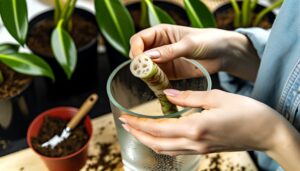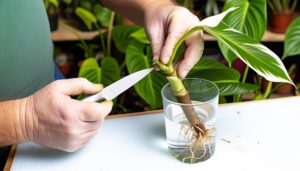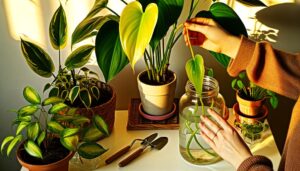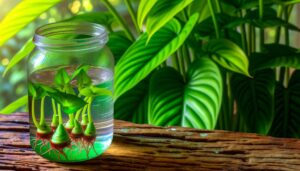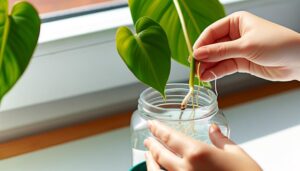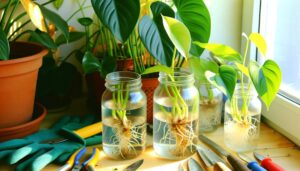Thai Sunrise Philodendron Propagation
Propagation of the Thai Sunrise Philodendron systematically involves several precise steps. Begin by assembling sterilized pruning shears, rooting hormone with auxins, well-draining potting mix, and appropriate containers.
Select a healthy, semi-mature stem with multiple nodes, ensuring its vigor and hydration. Using sterilized shears, make a clean cut just below a node, keeping one or two leaves intact.
Root the cutting in a moisture-retentive medium like sphagnum moss or perlite for ideal aeration and root development. Transplant the rooted cutting into well-draining soil, maintain consistent moisture, indirect light, and monitor for signs of stress or nutritional deficiency.
This approach facilitates robust propagation.
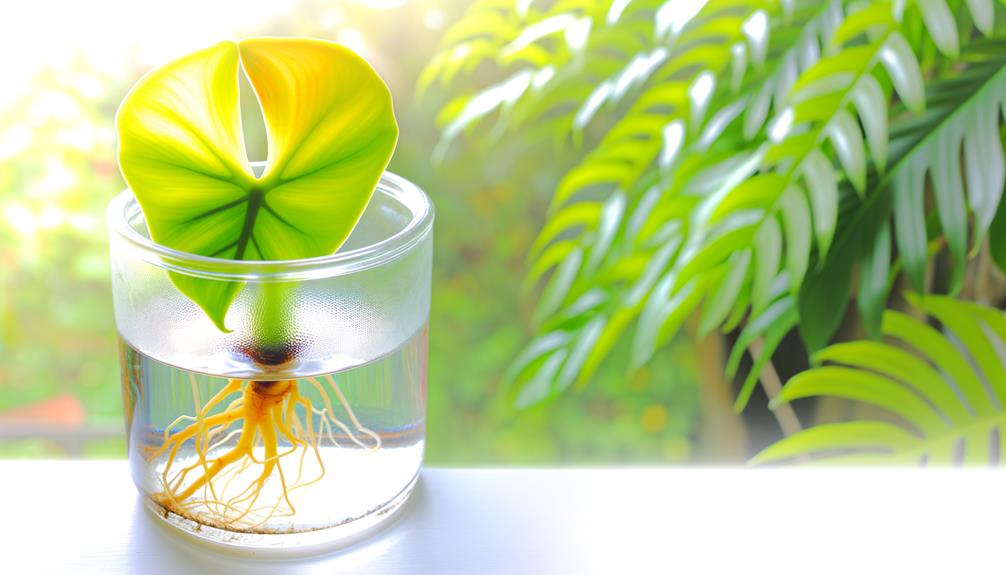
Key Takeaways
- Select a healthy, semi-mature stem with multiple nodes and vibrant foliage for propagation.
- Use sterilized pruning shears to make a precise cut below a node.
- Dip the cut end in rooting hormone and place in a well-draining medium like water, sphagnum moss, or perlite.
- Once roots develop, transplant the cutting into a pot with well-draining potting mix.
- Provide indirect sunlight, consistent humidity, and monitor for stress or nutrient deficiencies.
Gathering Tools and Materials
To successfully propagate a Thai Sunrise Philodendron, it is necessary to gather specific tools and materials. These include sterilized pruning shears, rooting hormone, well-draining potting mix, and appropriate containers.
Sterilized pruning shears minimize the risk of transmitting pathogens during the cutting process. Rooting hormone contains auxins that enhance root development, essential for the successful establishment of new plants. A well-draining potting mix, typically composed of peat, perlite, and bark, ensures ideal aeration and moisture retention, preventing root rot. Appropriate containers, such as small pots with drainage holes, facilitate adequate water flow and root expansion.
Assembling these materials prior to propagation ensures a streamlined process, thereby maximizing the likelihood of successful plant propagation.
Choosing a Healthy Stem
Selecting a healthy stem is essential for successful propagation. It guarantees the new plant will have the strength needed for robust growth. When choosing a stem, prioritize one that shows vigorous health. This is characterized by vibrant coloration and the absence of any signs of disease or pest infestation.
The ideal stem should be semi-mature, neither too young nor too old, to ensure optimal rooting potential. Inspect for nodes, as these are crucial points for root development. A stem with multiple nodes is advantageous. Additionally, verify the stem's turgidity—firmness indicates adequate hydration and vitality.
Avoid stems with yellowing leaves, mechanical damage, or fungal infections, as these can compromise the propagation process. Opt for stems with lush, healthy foliage to promote successful growth and establishment.
Making the Cut
Once a healthy stem has been selected, the next crucial step involves making a precise cut just below a node using sterilized, sharp pruning shears. This method guarantees the propagation material retains essential growth hormones concentrated at the node, facilitating successful root development. Employing sterilized tools prevents pathogenic contamination, thereby reducing the risk of infection.
It is vital to execute a clean, single cut to minimize tissue damage and promote efficient healing. The cutting should ideally include at least one or two leaves to sustain photosynthetic activity. Ensuring proper technique in making the cut is paramount for fostering robust, healthy new growth in the Thai Sunrise Philodendron, setting the stage for subsequent rooting and establishment.
Rooting the Cutting
Initiating the rooting process involves placing the freshly cut stem in an appropriate rooting medium to encourage root development. The choice of medium is essential for the best root formation. Commonly used mediums include water, sphagnum moss, and perlite. These mediums provide the necessary moisture and aeration for root growth.
Water:
Submerge the cut end in water, ensuring it remains clean to prevent bacterial growth.
Sphagnum Moss:
This medium retains moisture while providing sufficient aeration, reducing the risk of rot.
Perlite:
A well-draining medium ensuring roots receive adequate oxygen, thereby promoting robust root development.
Each medium has its advantages, and the selection depends on individual preferences and environmental conditions. Ensuring consistent moisture levels is crucial for successful rooting.
Transplanting and Care
After establishing a healthy root system in the chosen medium, the next step involves transplanting the rooted cutting into soil to promote growth and development. Select a well-draining potting mix, typically consisting of peat, perlite, and orchid bark, ensuring ideal aeration and moisture retention.
Gently place the rooted cutting into the prepared soil, making sure that the roots are adequately covered and the cutting is stable. Water thoroughly, allowing excess moisture to drain, and place the plant in indirect sunlight. Maintain a consistent humidity level of 60-70%, as insufficient humidity can impede growth.
Monitor the plant for signs of stress or nutrient deficiencies, adjusting care protocols as needed to ensure robust development and sustained health of the Thai Sunrise Philodendron.
Conclusion
In the world of botanical propagation, the journey of the Thai Sunrise Philodendron mirrors the transformation of a chrysalis into a butterfly. By carefully gathering tools, choosing a strong stem, making exact cuts, and nurturing the cutting through rooting, one secures successful transplantation and growth.
This process, similar to nature's own elaborate dance, demonstrates the mutual connection between horticultural practice and plant essentiality, ultimately nurturing a flourishing specimen that stands as proof of scientific accuracy and ecological balance.

